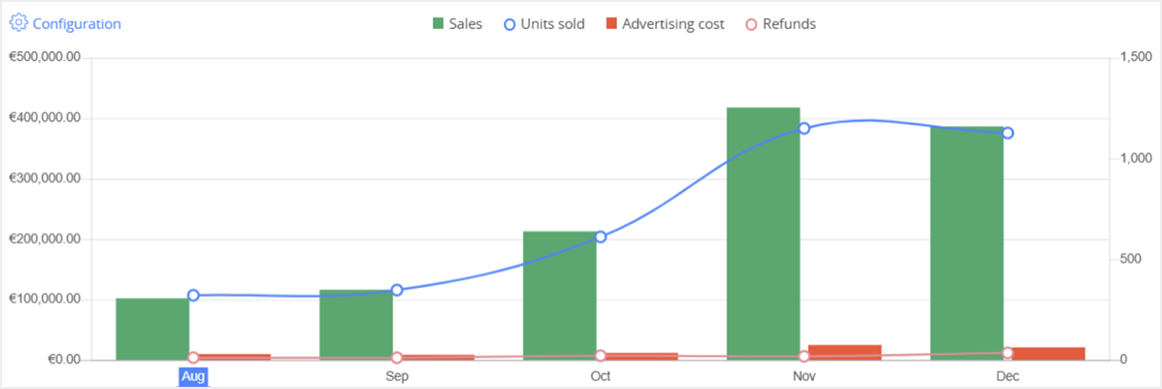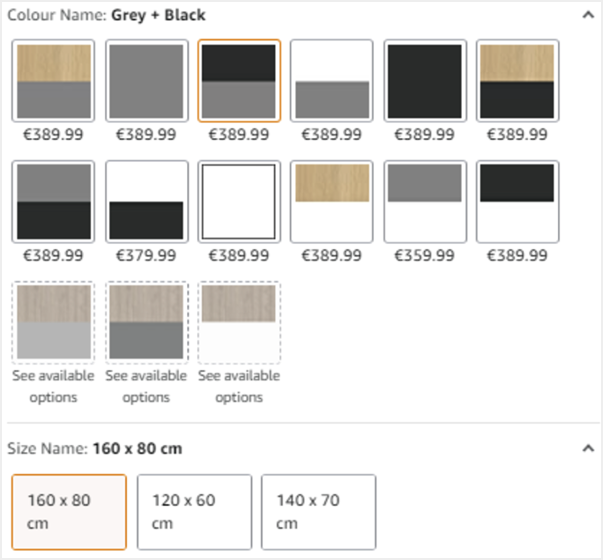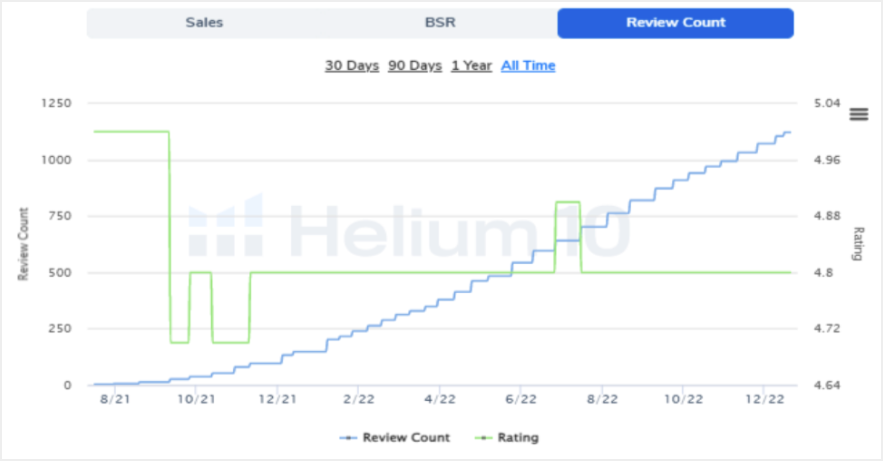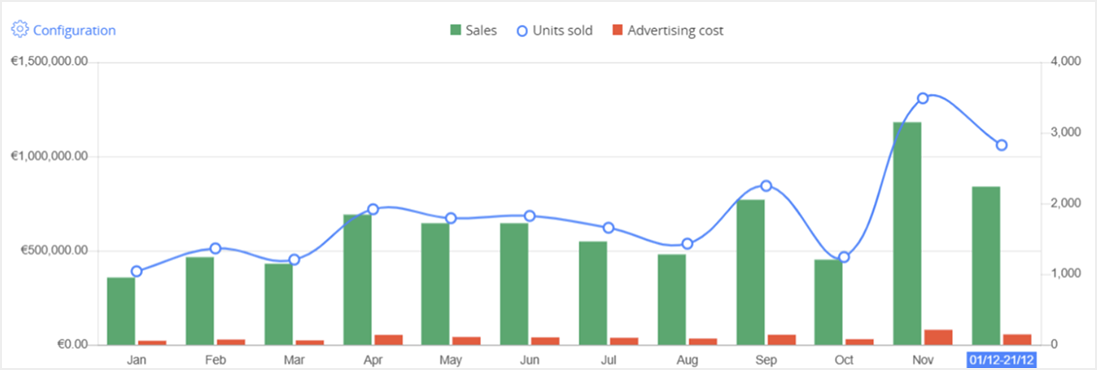Some brands come to Amazon to sell. Others come to dominate.
When we first connected with this Office products brand, it was clear they had something special. It had a high-ticket product, strong market traction, and big ambitions. But potential without direction rarely scales. This is how we turned their seasonal spark into a best-selling engine.
Some brands come to Amazon to sell. Others come to dominate.
When we first connected with this Office products brand, it was clear they had something special. It had a high-ticket product, strong market traction, and big ambitions. But potential without direction rarely scales. This is how we turned their seasonal spark into a best-selling engine.
This client is selling on Amazon Germany, using a hybrid fulfillment model. While the smaller products are Fulfilled by Amazon (FBA), the hero product — a large, two-part item available in multiple sizes and colors — is Fulfilled by Merchant (FBM).
Given its size and premium price point (€300–€400 per unit), FBM proved to be the most efficient model, helping the brand avoid high Amazon storage and fulfillment fees. As a result, the majority of revenue and profit comes from this FBM-listed hero product.
This client is selling on Amazon Germany, using a hybrid fulfillment model. While the smaller products are Fulfilled by Amazon (FBA), the hero product — a large, two-part item available in multiple sizes and colors — is Fulfilled by Merchant (FBM).
Given its size and premium price point (€300–€400 per unit), FBM proved to be the most efficient model, helping the brand avoid high Amazon storage and fulfillment fees. As a result, the majority of revenue and profit comes from this FBM-listed hero product.
This client is selling on Amazon Germany, using a hybrid fulfillment model. While the smaller products are Fulfilled by Amazon (FBA), the hero product — a large, two-part item available in multiple sizes and colors — is Fulfilled by Merchant (FBM).
Given its size and premium price point (€300–€400 per unit), FBM proved to be the most efficient model, helping the brand avoid high Amazon storage and fulfillment fees. As a result, the majority of revenue and profit comes from this FBM-listed hero product.
This client is selling on Amazon Germany, using a hybrid fulfillment model. While the smaller products are Fulfilled by Amazon (FBA), the hero product — a large, two-part item available in multiple sizes and colors — is Fulfilled by Merchant (FBM).
Given its size and premium price point (€300–€400 per unit), FBM proved to be the most efficient model, helping the brand avoid high Amazon storage and fulfillment fees. As a result, the majority of revenue and profit comes from this FBM-listed hero product.
The client reached out to us 4 years ago with one goal: to scale on Amazon.
Their hero product showed clear potential, but the account lacked strategic structure, both in A+ content and PPC. After our initial audit and a few consultations, they took action and quickly saw results, growing from €102K in August to €418K in November, finishing the year with €1.4M in total sales. The last 2 months of year have accumulated €804k of sales, which accounts for 56,3% of all their annual revenue.
But even with this success, much of their potential remained untapped.
Recognizing the need for a long-term strategy, the brand gave us full control of the account in January, and that’s when the real transformation began.
August – December sales graph:

Revenue in August, November, and December:


The client reached out to us 4 years ago with one goal: to scale on Amazon.
Their hero product showed clear potential, but the account lacked strategic structure, both in A+ content and PPC. After our initial audit and a few consultations, they took action and quickly saw results, growing from €102K in August to €418K in November, finishing the year with €1.4M in total sales. The last 2 months of year have accumulated €804k of sales, which accounts for 56,3% of all their annual revenue.
But even with this success, much of their potential remained untapped.
Recognizing the need for a long-term strategy, the brand gave us full control of the account in January, and that’s when the real transformation began.
August – December sales graph:

Revenue in August, November, and December:


Listing optimization
As soon as we started actively managing this account, we saw opportunities to improve their conversion rates by optimizing their listings.
Rewrote all product pages using SEO-friendly copy, incorporating the most relevant keywords to improve visibility and conversion rates.
We Enhanced hidden listing data by adding keyword variations, synonyms, and common misspellings — helping the product rank for additional high-intent search terms not visible in the front end.
Previously, the product used a single-attribute variation (size), even though it came in multiple colors. We created a two-attribute variation (size and color) and added swatch images to elevate the visual experience and premium appeal.
Two-attribute variation of size and color, with swatch images:

The new super-listing improved organic keyword coverage and significantly enhanced the product’s Best Seller Rank by merging traffic and engagement into a single, stronger listing.
Instead of scattered reviews (7 to 50 per variation), the merged listing immediately showcased over 200 high-rated reviews
(4.5–5 stars). Since then, the hero product has maintained stable review growth — a key factor in both conversion and organic ranking.
Stable review growth:

Restructuring advertising
Advertising on Amazon is the most effective paid tool to rank organically and scale sales. But the structure in place was limiting performance. Here’s how we rebuilt their advertising strategy from the ground up.
The brand was using 2nd optimization level campaigns, where each campaign contained three ad groups per match type. While this setup gathered broad data, it often buried high-potential keywords and made it impossible to optimize placements per target.
We restructured the entire PPC strategy into single-target campaigns. This allowed us to isolate performance by keyword or competitor, giving us full control over budget, placements, and outcomes.
Though this structure requires more manual work, it enabled smarter budget allocation and long-term visibility gains. We focused ad spend on the most relevant keywords to support both paid and organic growth.
Sales growth in Year 1 with AMZ Bees:

Since we started working together, the brand showed steady growth, temporarily interrupted by multiple out-of-stock periods, including moments when all ASINs in the variation were unavailable.
BSR spikes when products go out of stock:
To regain lost rankings after restocking, we increased advertising budgets temporarily. This led to short-term TACoS spikes, but restoring sales velocity was the priority. Rankings recovered within weeks, and efficiency followed soon after.
Reaching top organic positions
To secure the best-seller badge, we had to dominate organic rankings for the most relevant search terms. We identified 75 high-intent keywords and built a strategy around them. Thanks to Helium10, we were tracking their performance by prioritizing the ones with the highest potential and adjusting ad spend accordingly.
Instead of spreading budgets thin, we focused on the keywords that mattered most. Helium10 also revealed which ASIN in our variation ranked best for each keyword, helping us decide which products to push where. With strong conversion rates and continuous optimization, our hero product climbed to the top of search results, cementing its position as a category leader.
Helium10 keyword tracker data:

Listing optimization
As soon as we started actively managing this account, we saw opportunities to improve their conversion rates by optimizing their listings.
Rewrote all product pages using SEO-friendly copy, incorporating the most relevant keywords to improve visibility and conversion rates.
We Enhanced hidden listing data by adding keyword variations, synonyms, and common misspellings — helping the product rank for additional high-intent search terms not visible in the front end.
Previously, the product used a single-attribute variation (size), even though it came in multiple colors. We created a two-attribute variation (size and color) and added swatch images to elevate the visual experience and premium appeal.
Two-attribute variation of size and color, with swatch images:

The new super-listing improved organic keyword coverage and significantly enhanced the product’s Best Seller Rank by merging traffic and engagement into a single, stronger listing.
Instead of scattered reviews (7 to 50 per variation), the merged listing immediately showcased over 200 high-rated reviews
(4.5–5 stars). Since then, the hero product has maintained stable review growth — a key factor in both conversion and organic ranking.
Stable review growth:

Restructuring advertising
Advertising on Amazon is the most effective paid tool to rank organically and scale sales. But the structure in place was limiting performance. Here’s how we rebuilt their advertising strategy from the ground up.
The brand was using 2nd optimization level campaigns, where each campaign contained three ad groups per match type. While this setup gathered broad data, it often buried high-potential keywords and made it impossible to optimize placements per target.
We restructured the entire PPC strategy into single-target campaigns. This allowed us to isolate performance by keyword or competitor, giving us full control over budget, placements, and outcomes.
Though this structure requires more manual work, it enabled smarter budget allocation and long-term visibility gains. We focused ad spend on the most relevant keywords to support both paid and organic growth.
Sales growth in Year 1 with AMZ Bees:

Since we started working together, the brand showed steady growth, temporarily interrupted by multiple out-of-stock periods, including moments when all ASINs in the variation were unavailable.
BSR spikes when products go out of stock:
To regain lost rankings after restocking, we increased advertising budgets temporarily. This led to short-term TACoS spikes, but restoring sales velocity was the priority. Rankings recovered within weeks, and efficiency followed soon after.
Reaching top organic positions
To secure the best-seller badge, we had to dominate organic rankings for the most relevant search terms. We identified 75 high-intent keywords and built a strategy around them. Thanks to Helium10, we were tracking their performance by prioritizing the ones with the highest potential and adjusting ad spend accordingly.
Instead of spreading budgets thin, we focused on the keywords that mattered most. Helium10 also revealed which ASIN in our variation ranked best for each keyword, helping us decide which products to push where. With strong conversion rates and continuous optimization, our hero product climbed to the top of search results, cementing its position as a category leader.
Helium10 keyword tracker data:

After taking over the account and focusing on sustainable, data-driven growth, the numbers speak for themselves.

After taking over the account and focusing on sustainable, data-driven growth, the numbers speak for themselves.

Today, this brand isn’t just a top performer in its niche! It’s a benchmark!
With strategic listing updates, refined PPC structure, and data-driven execution, we built a foundation that not only boosted revenue but secured long-term leadership on Amazon.
Today, this brand isn’t just a top performer in its niche! It’s a benchmark!
With strategic listing updates, refined PPC structure, and data-driven execution, we built a foundation that not only boosted revenue but secured long-term leadership on Amazon.